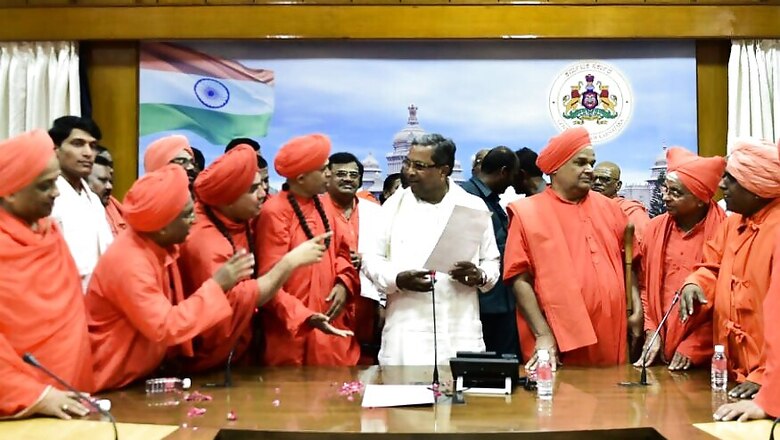
views
Bengaluru: Sometime in early 1950s, during the height of Karnataka Ekeekarana Andolana (Karnataka Unification Movement), top leaders of the Vokkaliga caste had gathered at a house in central Bengaluru to decide the future course of action.
All of them were Congress leaders and had participated in the freedom movement. Most had impeccable personal credentials. But majority of them were not too enthusiastic about the unification of all Kannada speaking areas under one administration. They had many reasons for that.
Some argued that Maharaja’s Mysore or Old Mysore was already a well-developed model state, and merging poor Mumbai-
Karnataka and Hyderabad – Karnataka regions would be a burden on the state exchequer and resources. Others had bigger fears.
They argued that once all Kannada speaking areas unite, the Vokkaligas will lose their caste dominance, paving way for the Lingayat hegemony. Two most powerful castes of the state were wary of each other even then.
But the then chief minister of old Mysore state, Kengal Hanumanthaiah, was all for state unification. A freedom fighter and an able administrator, Hanumanthaiah was a tall leader of the Vokkaligas.
Vetoing his own caste leaders, Hunumanthaiah told them that future generations of Kannadigas would never forgive them if they oppose unification for caste and political reasons.
The Vokkaliga leader threw his might behind the unification movement and the new Mysore state with Kannada-speaking regions of Bombay Presidency – including some districts of present-day Karnataka, Nizam’s Hyderabad, Karnataka, Madras Presidency and an independent, tiny state of Kodagu (Coorg) was born on November 1, 1956.
Sadly, Kengal Hanumanthaiah lost power and a Lingayat strongman, S Nijalingappa, took charge as the first chief minister of New Mysore state. As expected the Vokkaligas lost the chief minister’s chair to Lingayats and they had to wait for 38 years to reclaim the chair. In 1994, H D Deve Gowda became the first Vokkaliga chief minister of united Karnataka.
Between 1956 and 1972, four Lingayat chief ministers (S Nijalingappa, B D Jatti, S R Kanthi and Veerendra Patil) ruled the state. Between 1972 and 1983, a Kshatriya D Devaraja Urs and a Brahmin R Gundurao ruled the state minus much Lingayat backing. Ramakrishna Hegde, who became Karnataka’s first non-Congress chief minister in 1983, was also considered a Lingayat leader even though he was a Brahmin.
To end Hegde’s rule, the then Prime Minister and Congress president Rajiv Gandhi made a Lingayat stalwart Veerendra Patil KPCC president and chief ministerial candidate in 1989. Under his leadership, the Congress swept the polls by winning 181 seats in the 224-member house.
After Patil was unceremoniously removed by Rajiv Gandhi at Bengaluru airport in October 1990, the Lingayats once again started moving away from the Congress. In 1994, the combined strength of Lingayats and Vokkaligas decimated the Congress which managed to win just 36 assembly seats under then Chief Minister M Veerappa Moily.
These instances prove that without Lingayats’ backing no political party in Karnataka can really come to power and even if it manages, it may not be able to remain in power for long. Since the unification of state, Lingayats have dominated the socio-political life of Karnataka, forcing the Vokkaligas to play second fiddle to them. With their political and economic power, the Lingayats control the biggest vote bank in the state.
Contrary to the recent claims of the saffron parivar, Lingayats are not the traditional backers of the BJP. They were once the backbone of the Congress in Karnataka. After Devaraja Urs ended Lingayat hegemony in the party, they shifted to Janata Parivar. After the disintegration of the Janata experiment, they started backing the BJP and accepted B S Yeddyurappa as their leader.
In the present Assembly, there are over 45 Lingayat MLAs. In 1989, there were 89 of them. It came down to 68 in the subsequent assembly polls held in 1994. With Other Backward Classes (OBCs) asserting their power, the Lingayat representation is declining in the Assembly. But they still form 20-25% of the MPs and MLAs from the state irrespective of the party in power.
According to political analysts, Lingayats decide the outcome in close to 100 Assembly seats and 14 Lok Sabha seats in the state. In Mumbai – Karnataka and Hyderabad – Karnataka region they are the deciding factor in about 70 Assembly seats. These two regions together have 94 Assembly seats and 12 Lok Sabha seats.
In Vokkaliga-dominated Old Mysore region with 89 Assembly seats, Lingayats play an important role in deciding the fate of candidates in about 30 Assembly seats. According to some unauthenticated data, Lingayats have 30-35% population in 85-90 Assembly seats and they have 10-15% population in 45-50 seats.
Even though the Lingayats claim that their population is over 17% of the state’s total population, the leaked “caste census” report says they form 14% of the population and count only after Dalits and Muslims with 19.5% and 16% respectively. The Vokkaligas have 11% population, the census reveals.
The Siddaramaiah government’s audacious move to accord an independent religion tag to Lingayats is being seen as a big political decision of the new millennium. Siddaramaiah knows that winning back the trust of Lingayats is crucial for the Congress in future and it will also weaken the BJP substantially.
With majority Vokkaligas firmly supporting Gowda’s JDS, breaching BJP’s Lingayat fortress would be the most brilliant thing to do only if it works. Siddaramaiah knows that. But will it work? We will get the answer on the day of counting of votes.

















Comments
0 comment